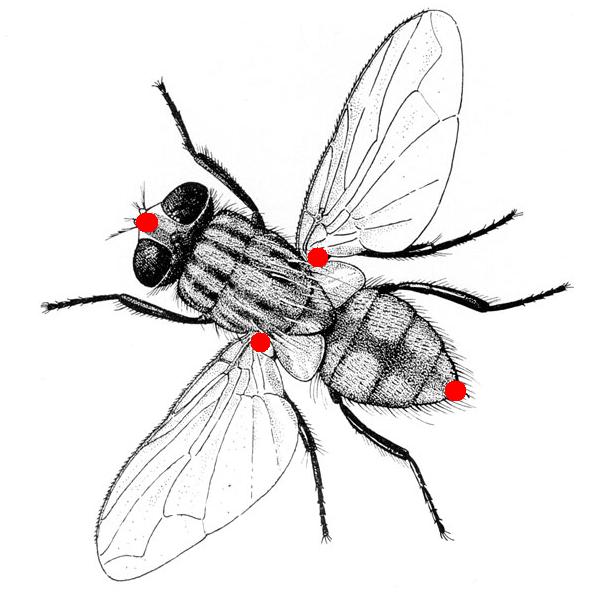Find vector running from tail to head and normalise it: call the result $\hat{Z}^\prime$.
Find vector joining left wing point to right wing pointand normalise it: call the result $\hat{Y}^\prime$.
Optional: do sanity check that $\left<\hat{Y}^\prime,\,\hat{Z}^\prime\right>=0$
Now calculate $\hat{X}^\prime = \hat{Y}^\prime\times\hat{Z}^\prime$.
Gather the three vectors as column vectors into the matrix $U = \left(\hat{X}^\prime\, \hat{Y}^\prime\,\hat{Z}^\prime\right)$. This is the rotation matrix that rotates your reference $\hat{X},\,\hat{Y},\,\hat{Z}$ basis into the basis aligned to the fly.
To convert to angles, we need to calculate the axis of rotation and the angle of rotation. This is most readily done by looking at the Rodrigues formula for a general member $\exp\left(H_{3\times 3}\right)$ of $SO(3)$ "backwards"
$$\exp\left(H_{3\times 3}\right)=I_{3\times3}+\frac{\sin\left(||H_{3\times 3}||\right)}{||H_{3\times 3}||}\,H_{3\times 3} +\frac{1-\cos\left(||H_{3\times 3}||\right)}{||H_{3\times 3}||^2}\,H_{3\times 3}^2\tag{1}$$
where:
$$H_{3\times3} = \left(\begin{array}{ccc}0&z&-y\\-z&0&x\\y&-x&0\end{array}\right)\tag{2}$$
and
$$||H_{3\times3}||=\sqrt{x^2+y^2+y^2}\tag{3}$$
where $x,\,y,\,z$ are the components of the axis of rotation and $\sqrt{x^2+y^2+y^2}$ is the angle of rotation in radians. $H_{3\times3}$ is the member of the Lie algebra $\mathfrak{so}(3)$ that exponentiates to the rotation matrix.
So, we take the matrix $U$ you found above and compare it with (1): you can see in (1) that the skew-symmetric part is:
$$\frac{1}{2}(U-U^T) = \frac{\sin\left(||H_{3\times 3}||\right)}{||H_{3\times 3}||}\,H_{3\times 3}\tag{4}$$
and this will let you read off $H_{3\times3}$ and the rotation angle $||H_{3\times 3}||$.
Incidently, if you were doing this to build a tracking system for the fly, you would need to do something like find the least squares best fit to vectors $\hat{Z}^\prime$ and $\hat{Y}^\prime$: the raw data vectors would not quite be orthogonal owing to noisy data. Alternatively, you could choose 3 points on the fly, track these and find $\hat{Z}^\prime$ and $\hat{Y}^\prime$ as the orthogonal basis for the triangle's three sides. You wouldn't have to do least squares best fit then, but your tracking might be less accurate.

